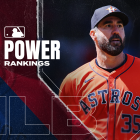There's still time for things to change -- we're not yet to the halfway point of the season -- but at this juncture the National League is dominating interleague play like never before. In 2019, NL teams are 71-56 against American League opponents, which comes to a winning percentage of .559. If that holds up, then it'll be the highest winning percentage ever posted by the NL in interleague play.
Let's put it in full historical context:
Overall, the AL has a .524 winning percentage in interleague play, and they've prevailed in 17 of the 22 full seasons to date. To say the least, that's a decided edge. Last year, though, the NL broke a 14-year losing streak to the junior circuit, and thus far in 2019 they've fared even better.
if the NL's current .559 interleague win percentage holds up, then it'll be their highest such mark in the history of interleague play. The historically dominant AL has managed to best a .559 win percentage in just three seasons -- 2012, 2008, and 2006.
So what's going on? Last year, the NL managed to winnow down the AL's advantage when it comes to production from the designated hitter spot, which was a big driver of the AL's success in interleague home games for so many years. This year, it's the continued trend of tanking in the AL that's making the difference. In the NL, only one team -- the Marlins -- is making little effort at the roster level to win games. In the AL, the Orioles, Blue Jays, Tigers, Royals, and Mariners all fit that unfortunate description. (To be fair, with Kansas City it's more an instance of just being terrible rather than stripping the roster for parts.) Thus far in 2019, those five AL teams are a combined 10-30 in interleague play. The remainder of the AL is 46-41.
That doesn't undermine what the NL is doing this season -- the strength of a league is determined by its best, its most middling, and its worst. Rather, it just explains it. More to the point, it explains why the NL is getting the better of the AL to an extent we've never seen before.






















